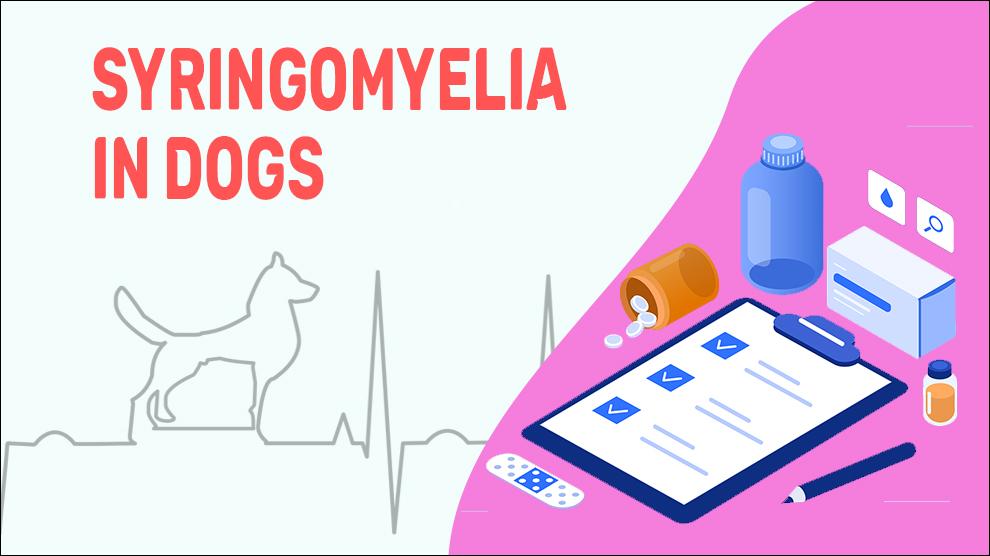What Is Syringomyelia In Dogs?
Syringomyelia (SM) is defined as a condition that results in the development of tiny pockets of fluid within the parenchyma of the spinal cord as a result of the altered flow of cerebrospinal fluid through the foramen magnum
The exact etiopathogenesis is unknown but SM is considered to develop secondary to a hindrance of cerebrospinal fluid flow at the level of the foramen magnum. Other documented etiologies causing SM include the reduced volume of the caudal fossa secondary to an improperly small occipital bone causing the cerebellum to herniate at the base of the skull. Similar to Chiari type I malformation in humans, this caudal fossa malformation and subsequent compression of the subarachnoid space can lead to the buildup of fluid in the spinal cord which causes Syringomyelia.
Neoplasia in the region of the brainstem or foramen magnum and spinal trauma are other causes of SM. Pain localized to the cervical spine is the most consistent clinical sign seen in SM-affected dogs. Many pet owners state that their dog shows postural pain after jumping demonstrated by unexpected vocalizing.
Syringomyelia is more common in brachycephalic breeds, with the cavalier King Charles spaniel among the most affected as the incidence of CM is an estimated 95%. Clinical signs can appear as early as 3 months of age in Cavalier King Charles spaniels and occurrence increases with age. Syringomyelia is prevalent in more than 50% of dogs with Chiari-type malformation.
Symptoms Of Syringomyelia In Dogs
- Extreme sensitivity to touch on the top of the head, neck, shoulders, chest, and back
- Sleeping with head held up/Holding head high at a certain angle to prevent pain
- Allodynia - Pain due to a nonpainful stimulus
- Phantom scratching (desperate scratching action towards the shoulder without actually touching the skin)
- Dysesthesia - Burning sensation
- Weakness of the extremities
- Inability to play or walk
- Seizures
- Irritability/Depression
- Paralysis
Treatment Options For Syringomyelia In Dogs
Cervical or cranial decompression surgery: This is done to remove any structures in the bone that is blocking the spinal column and to widen the foramen magnum. Almost 80% of the procedure is successful, however, in some cases (20%), the symptoms will return as the syrinx causes it to become blocked again. This can be due to the regrowth or scarring of the syrinx.
NSAIDs like
- Carprofen (Novox, Rimadyl, Canidryl, Rimifin, Vetprofen)
- Meloxicam (Loxicom, Metacam, Rheumocam, OroCAM)
- Firocoxib (Equioxx, Previcox)
- Deracoxib (Deramaxx, Novartis)
- Etodolac (Etobest , Etomax , Etofree)
Pain-relieving medications:
- Amantadine (Symmetrel, Osmolex, Gocovri)
- Tramadol (Ultram, Durela Rybix)
- Gabapentin (Encentin, Gabacent, Gabaciz)
Home Remedies For Syringomyelia In Dogs
Home-cooked diet, with wholesome, nutritious foods as a substitute for commercial diets.
How To Prevent Syringomyelia In Dogs?
When dogs are diagnosed with inherited types of SM, it is important to take measures to avoid breeding to eliminate affected dogs from the gene pool.
Discuss with your veterinary neurologist to know what is the suitable diet for your dog’s eyes and its overall health.
Affected Dog Breeds Of Syringomyelia
Small Dog Breeds, Brussels Griffon, Cavalier King Charles Spaniel, Bichon Frise, Boston Terrier, Bull Terrier, Chihuahua, French Bulldog, Havanese, English Toy Spaniel, Maltese, Miniature Dachshund, Miniature Poodle, Toy Poodle, Papillon, Pomeranian, Pug, Shih Tzu, Staffordshire Bull Terrier, Yorkshire Terrier
Causes And Types For Syringomyelia In Dogs
1. Causes:
- Congenital/inherited
- Immune-mediated
- Spinal tumors
- Trauma
2. Types:
- Grade 0 - Pre-syrinx or No syrinx/ no dilation
- Grade 1 - < 2 mm Central canal dilation (CCD)
- Grade 2 - > 2mm CCD with a pre-syrinx / syrinx
As SM is a progressive condition, each grade includes a letter corresponding with the dog’s age:
- A - > 5 years old
- B – 3-5 yrs old
- C – 1-3 yrs old
3. Mortality:
Syringomyelia can cause permanent damage and other complications. Although the Mortality rate associated with this condition is not yet documented, still this condition causes motor difficulties, such as stiffness in leg muscles and weakness that can affect a pet's walking.
4. Diagnosis:
- Complete blood count (CBC), an electrolyte panel, and a urinalysis
- CT SCAN/MRI
- Ultrasound
- Electrophysiology
- Tissue sample (biopsy)
5. Prognosis:
It is really difficult to foretell prognosis chances for complete recovery as the extent and severity of the condition varies so greatly from dog to dog. Unexpectedly your pet may be clear of clinical signs, but it may present with a new set of symptoms within a short period.
Most of the Syringomyelia cause can never be determined, the spinal condition will continue to worsen and your dog's disease will deteriorate.
When To See A Vet For Syringomyelia In Dogs?
Contact your vet right away, if you notice any of the following:
- Extreme sensitivity to touch on the top of the head, neck, shoulders, chest, and back
- Sleeping with head held up/Holding head high at a certain angle to prevent pain
- Allodynia - Pain due to a nonpainful stimulus
Food Suggestions For Syringomyelia In Dogs
- Antioxidants: Strawberries, Blueberries, Cranberries, Raspberries, Cooked yellow squash, Red cabbage, Steamed broccoli, kale, spinach, and green beans
- Complex Carbs: Brown Rice, Oatmeal, Whole Grains, Sweet Potatoes, etc
- Omega-3 fatty acids: Salmon, herring, mackerel, lake trout, tuna, sardines, etc
- B vitamins: Legumes, snap peas, green beans, carrots, cauliflower, broccoli, cabbage, tomatoes, citrus fruits, Blueberries, strawberries, cherries, etc
- Vitamin E: Avocado, Trout, Salmon, Spinach, Sunflower Oil, Safflower Oil, etc
- L-Carnitine: Chicken breast, Ground beef, shellfish, peanut butter, and avocados
- Alpha-lipoic acid: Organ meats, tomatoes, spinach, broccoli, Brussels sprout, etc
- Medium-Chain Triglycerides: Butter, milk, cheese, yogurt, etc
Conclusion
Whatever the course of the disease, complete recovery of the pet to the original condition or pre-onset state is not possible. So vets usually suggest monitoring the symptoms regularly and assessing your pet’s quality of life.

















